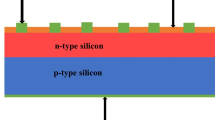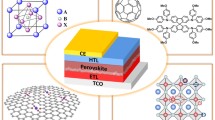Abstract
In this paper, a numerical model is used to analyze photovoltaic parameters according to the electronic properties of \({\text{InGaN/GaN}}\) multiple quantum-well solar cells (MQWSC) under hydrostatic pressure. Finite-difference methods are used to acquire energy eigenvalues, and their corresponding eigenfunctions of \({\text{InGaN/GaN}}\) MQWLED and the hole eigenstates are calculated via a \(6 \times 6\) k.p method under applied hydrostatic pressure. All symmetry-allowed transitions up to the fifth subband of the quantum wells (multi-subband model) and barrier optical absorption are considered. Further, the linewidth due to the carrier-carrier and carrier-longitudinal optical (LO) phonon scattering is considered. The result of the photoelectric current is compared with the single-subband model. According to the results, a change in pressure up to 10 GPa increases the intraband scattering time up to 38 fs for heavy holes and 40 fs for light holes, raises the height of the Lorentz function, reduces the excitonic binding energy, and decreases the photocurrent density up to \({\text{5mA}}/{\text{cm}}^{2}\). The multi-subband model positively affects the photocurrent density, increasing it by \({\text{4mA}}/{\text{cm}}^{2}\), contrary to the pressure function.










Similar content being viewed by others
References
C Boudaoud Comput. Simul. 167 194 (2020)
M Kuc et al. Materials 13 1444 (2020)
A Tian, L Hu, L Zhang, J Liu and H Yang Sci China Mater. 63 1348 (2020)
A Pandey, W J Shin, J Gim, R Hovden and Z Mi Photonics Res. 8 331 (2020)
X Huang et al Appl. Phys. Lett. 113 043501 (2018)
A G Bhuiyan and K Sugita J. Photovolt. 2 276 (2012)
J Wu, W Walukiewicz and E E Haller Phys. Lett. 80 4741 (2002)
R Yahyazadeh J. Interfaces Thin Films Low Dimens. Syst 3 279 (2021)
R Yahyazadeh, Z Hashempour J. Interfaces Thin Films Low Dimens. Syst 2, 183 (2019)
B Chouchen, M H Gazzah, A Bajahzar and H Belmabrouk AIP Adv. 9 045313 (2019)
Q Deng et al J. Phys. D Appl. Phys. 44 265103 (2011)
R Belghouthi and M Aillerie Energy Procedia 157 793 (2019)
B Chouchen, M H Gazzah, A Bajahzar and H Belmabrouk Materials 12 1241 (2019)
B Chouchen, A E Aouami, M H Gazzah, A Bajahzar, E Feddi, F Dujardin and H Belmabrouk Optik 199 163385 (2019)
R Yahyazadeh J. Photonics Energy 10 045504 (2020)
M H Gazzah and B Chouchen Sci. Semicond. Process. 93 123 (2019)
H Belmabrouk et al. Optik 207 163883 (2020)
X Huang et al. ACS Nano. 10 5145 (2016)
O Ambacher et al J. Appl. Phys. 87 334 (2000)
O Ambacher et al J. Phys. Condens. Matter. 14 3399 (2002)
Z J Feng, Z J Cheng and H Yue Chinese Phys. 13 1334 (2004)
V Fiorentini Phys. Lett. 80 1204 (2002)
P Perlin, L Mattos, N A Shapiro, J Kruger, W S Wong and T Sands J. Appl. Phys. 85 2385 (1999)
K J Bala Phys. 495 42 (2017)
I Vurgaftman J. Appl. Phys. 89 5815 (2001)
B Jogai J. Appl. Phys. 93 1631 (2003)
B Jogai Phys. stat. sol (b) 233 506 (2002)
V B Yekta and H Kaatuzian Optik 122 514 (2011)
J Piprek Semiconductor Optoelectronic Devices: Introduction to Physics and Simulation, (San Diego California: Elsevier) p. 127 (2013)
P S Zory Quantum well lasers, (Boston: Academic Press) p. 62 (1993)
C D Mahan Many-body particle physics, (New York and London: Plenum press) p. 187 (1990)
W Wang, G Liu, P Jin, D Mao, W Li, Z Wang, W Tian and C Chen Chin. Phys. B 23 117803 (2014)
R Yahyazadeh and Z Hashempour J. Optoelectron. Nanostruct. 5 81 (2020)
S H Ha and S L Ban J. Phys. Condens. Matter. 20 085218 (2008)
J G Rojas-Briseno, I Rodriguez-Vargas, M E Mora-Ramos and J C Martínez-Orozco Phys. E 124 114248 (2020)
P Harrison and A Valavanis Quantum Wells, Wires and Dots: Theoretical and Computational Physics of Semiconductor Nanostructures, 4th edn. (New York: John Wiley & Sons) (2016)
E Kasapoglu, H Sari and N Balkan Sci. Technol. 15 219 (2000)
J G Rojas-Briseño, J C Martínez-Orozco and M E Mora-Ramos Superlatt. Microstruct. 112 574 (2017)
R Yahyazadeh and Z Hashempour J. Sci. Technol. 13 1 (2021)
S L Chung and C S Chang Phys. Rev. B 54 2502 (1996)
S Adachi Physical Properties of III-V compounds. (New York: John Wiley & Sons) (1992)
S R Chinn J. Quantum Electron. 24 2191 (1988)
I Tan and G L Snider J. Appl. Phys. 68 4071 (1990)
Z Dongmei, W Zongchi and X Boqi J. Semicond. 33 052002 (2012)
S L Chuang Physics of Optoelectronic Devices, 2nd edn. (New York: John Wiley & Sons) (1995)
S Asgharzadeh, M Javidnassab, A Asgari and M R Keramati J. Photonics Energy 7 015502 (2017)
C I Cabrera, J C Rimada, J P Connolly and L Hernandez J. Appl. Phys. 113 024512 (2013)
N E Gorji, H Movla, F Sohrabi, A Hosseinpour, M Rezaei and H Babaei Phys. E 42 2353 (2010)
B K Ridly, W J Schaff and L F Estman J. Appl. Phys. 94 3972 (2003)
Author information
Authors and Affiliations
Corresponding author
Additional information
Publisher's Note
Springer Nature remains neutral with regard to jurisdictional claims in published maps and institutional affiliations.
Appendices
Appendix A: Numerical method
The discretization of Schrodinger and Poisson equations has been performed using finite-difference method. A centered second order scheme is used. Therefore, a continuous term such as \(\frac{d}{dz}\left( {f\frac{d\psi }{{dz}}} \right)\) is discretized according to:
The Schrodinger equation becomes: \(H\psi_{i} = E\psi_{i}\) The nonzero elements of the matrix H are:
It is straightforward to obtain the matrix system related to the Poisson equation.
The above eigenvalues system and linear system are coupled and should be solved using an iterative method. The convergence is obtained when the difference on the Fermi level associated to two consecutive iterations is smaller than \(10^{ - 4} {\text{eV}}\). The boundary conditions related to Schrodinger equation are:
where L is the total height of the structure. The boundary conditions related to Poisson equation are:
The details of the self-consistent solution of the Schrodinger–Poisson equation are as follows:
-
1.
Consider the optional value for \(n_{2D}\).
-
2.
Solve the Poisson equation.
-
3.
Solve the Schrodinger equation and obtain the wave functions and their energy subbands.
-
4.
Using the following equations, we obtain the electron density and the Fermi energy [10, 17].
$$n_{2D} = \mathop \sum \limits_{i = 1}^{5} \frac{{m^{*} k_{B} T}}{{\pi \hbar^{2} }}ln\left[ {1 + {\text{exp}}(\frac{{E_{F} - E_{i} }}{{k_{B} T}}} \right]\left| {\psi_{i} } \right|^{2}$$(20)$$\sum\limits_{i = 1}^{5} {n_{2D} } - N_{D}^{2D} \left[ {1 - \frac{1}{{1 + \frac{1}{2}\exp (\frac{{E_{D} - E_{F} }}{{k_{B} T}})}}} \right] - \frac{{\sigma_{b} }}{e} = 0$$(21)where \({\text{N}}_{{\text{D}}}^{{{\text{2D}}}} {{ = 2 \times 10}}^{{{12}}} {\text{cm}}^{{ - 2}}\) is the doping density. The parameter \({\text{E}}_{{\text{D}}} {\text{ = 28meV}}\) is the donors binding energy. Also, \(\sigma_{b}\) is the surface polarization density in InGaN/GaN [10].
-
5.
If it is \(E_{F\left( n \right)} - E_{{F\left( {n - 1} \right)}} < 10^{ - 4} {\text{eV}}\), the self-consistent program will end. Otherwise(\(E_{F\left( n \right)} - E_{{F\left( {n - 1} \right)}} > 10^{ - 4} {\text{eV}}\)), put new \(n_{2D}\) in Schrodinger’s equation and continue the program until condition \(E_{F\left( n \right)} - E_{{F\left( {n - 1} \right)}} < 10^{ - 4} {\text{eV}}\) is established.
During the calculations, the same grid mesh is used for both Poisson and Schrödinger’s equation. For mesh refinement in the numerical calculation written in the MATLAB software, commands initmesh and refinemesh are performed as follows in different regions of structure InGaN/GaN.
fem. mesh = initmesh (fem,'hmax',[0.05e-9],'hmaxfact',1,'hgrad',1.3, 'zscale',1.0);
fem. mesh = refinemesh (fem, 'mcase',0);
Where there are fem commands in solving wave functions, hmax is the maximum edge size which is equal to 0.05e-9 m, hgrad is the mesh growth rate which is equal to 1.3, zscale is a region to be refined.
Appendix B: Electric fields
Assuming no free charge, electric displacements at interface between \(\left( j \right)\) th and \(\left( {j + 1} \right)\) th layers and between \(\left( {j + 1} \right)\) th and \(\left( {j + 2} \right)\) th layers can be expressed as follows[49]:
Substituting from Eq. 22 gives an expression for Eq. 23:
where \(\varepsilon_{j}\) represents the dielectric constants and \(P_{j}\) is the polarization in jth layer. It follows that the field in any layer is related to field in a particular layer as in the following:
We focus on the case where there is no voltage difference across MQW either because thermodynamic equilibrium prevails or an applied field exists that compensates any built-in field. The condition, in which the volt value dropped across MQW is zero, is as follows:
Here, \(L_{k}\) and \(L_{j}\) are the kth and jth layers thickness. Substituting from Eq. 26 gives an expression for electric field in any layer:
In the case of a MQW with only two types of layers (\(L_{w}\) and \(L_{b}\)), the fields are:
In these equations, the difference in polarization density is equal to surface polarization density in InGaN/GaN, which is calculated by the following equation [10]:
where
Here, \(\in\) is the basal strain whose relation is presented in the main text.
Appendix C: Intraband relaxation time
The linewidth due to the carrier-carrier scattering is obtained from the perturbation expansion of one particle Green’s functions. The linewidth for carrier-carrier scattering is given by:
where n refers to conduction (n = c) or valence (n = v) bands, \(i\), \(i^{\prime}\),\(j\), and \(j^{\prime}\) are the subband numbers of the QW structure, and \(f_{n} \left( E \right)\) is the Fermi distribution function. The interaction matrix element \(V_{nm}\) in a two-dimensional QW is given by
where the z-axis is perpendicular to the well interface, A is the interface area of the sample, and the δ notation represents momentum conservation within a plane parallel to the well interface. \(\phi_{nj} \left( {z_{1} } \right)\), is the wave function of carrier, which are obtained by self-consistent solution of the Schrodinger–Poisson equation for electrons and k.p method for holes. \(\lambda_{s}\), is the inverse screening length and its relation is as follows [33]
Here \(m_{cj}\) and \(m_{vj}\) are the effective masses of electrons and holes in the conduction and valence bands, which will be explained in the following. For carrier-longitudinal optical (LO) phonon scattering, the linewidth broadening is obtained by taking the imaginary part of the one-phonon self-energy [34]
where \(\hbar \omega_{LO} = 91.13meV^{ - 1}\) is the energy of the LO phonon and \(n_{q}\) is the phonon number per mode, given by \(n_{q} = {1 \mathord{\left/ {\vphantom {1 {\left[ {\exp \left( {\beta \hbar \omega_{LO} } \right) - 1} \right]}}} \right. \kern-\nulldelimiterspace} {\left[ {\exp \left( {\beta \hbar \omega_{LO} } \right) - 1} \right]}}\) 1]. The matrix element \(P_{n}\) for carrier-LO phonon scattering in a two-dimensional QW is given by
where \(\varepsilon_{\infty }\) is the optical dielectric constants, \(q_{z}\) is the phonon wave vector perpendicular to the well interface and V is the volume of the system. The intraband relaxation time \(\tau_{in}\) is obtained from Eqs. 33 and 36 as \({\hbar \mathord{\left/ {\vphantom {\hbar {\tau_{in} = \Gamma_{{cjk_{\parallel } }} (E)}}} \right. \kern-\nulldelimiterspace} {\tau_{in} = \Gamma_{{cjk_{\parallel } }} (E)}} + \Gamma_{{vjk_{\parallel } }} (E)\).
Rights and permissions
About this article
Cite this article
Yahyazadeh, R. Effect of hydrostatic pressure on the photocurrent density of \({\mathbf{InGaN/GaN}}\) multiple quantum well solar cells. Indian J Phys 96, 2815–2826 (2022). https://doi.org/10.1007/s12648-021-02218-7
Received:
Accepted:
Published:
Issue Date:
DOI: https://doi.org/10.1007/s12648-021-02218-7




